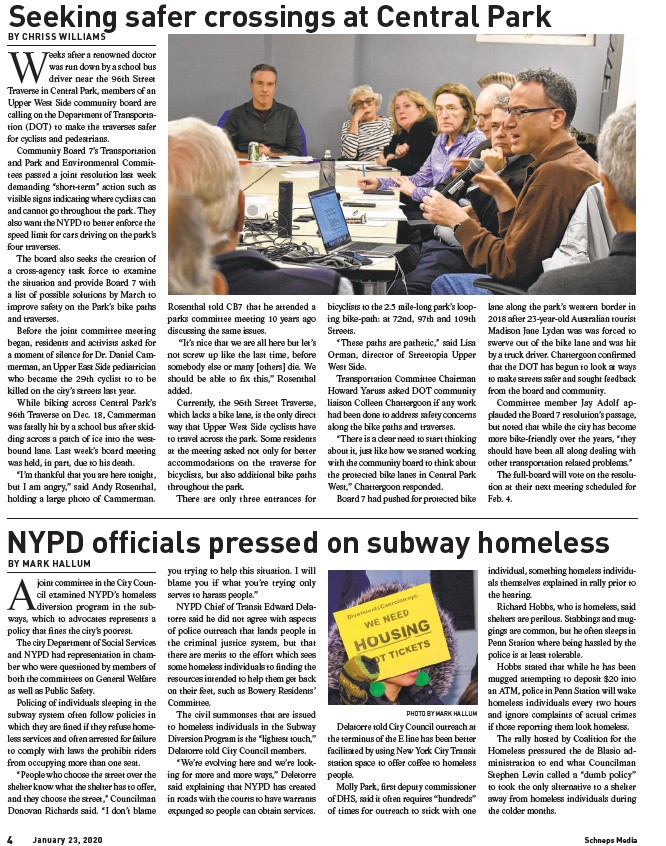
Seeking safer crossings at Central Park
BY CHRISS WILLIAMS
Weeks after a renowned doctor
was run down by a school bus
driver near the 96th Street
Traverse in Central Park, members of an
Upper West Side community board are
calling on the Department of Transportation
(DOT) to make the traverses safer
for cyclists and pedestrians.
Community Board 7’s Transportation
and Park and Environmental Committees
passed a joint resolution last week
demanding “short-term” action such as
visible signs indicating where cyclists can
and cannot go throughout the park. They
also want the NYPD to better enforce the
speed limit for cars driving on the park’s
four traverses.
The board also seeks the creation of
a cross-agency task force to examine
the situation and provide Board 7 with
a list of possible solutions by March to
improve safety on the Park’s bike paths
and traverses.
Before the joint committee meeting
began, residents and activists asked for
a moment of silence for Dr. Daniel Cammerman,
an Upper East Side pediatrician
who became the 29th cyclist to to be
killed on the city’s streets last year.
While biking across Central Park’s
96th Traverse on Dec. 18, Cammerman
was fatally hit by a school bus after skidding
across a patch of ice into the westbound
lane. Last week’s board meeting
was held, in part, due to his death.
“I’m thankful that you are here tonight,
but I am angry,” said Andy Rosenthal,
holding a large photo of Cammerman.
Rosenthal told CB7 that he attended a
parks committee meeting 10 years ago
discussing the same issues.
“It’s nice that we are all here but let’s
not screw up like the last time, before
somebody else or many others die. We
should be able to fix this,” Rosenthal
added.
Currently, the 96th Street Traverse,
which lacks a bike lane, is the only direct
way that Upper West Side cyclists have
to travel across the park. Some residents
at the meeting asked not only for better
accommodations on the traverse for
bicyclists, but also additional bike paths
throughout the park.
There are only three entrances for
bicyclists to the 2.5 mile-long park’s looping
bike-path: at 72nd, 97th and 109th
Streets.
“These paths are pathetic,” said Lisa
Orman, director of Streetopia Upper
West Side.
Transportation Committee Chairman
Howard Yaruss asked DOT community
liaison Colleen Chattergoon if any work
had been done to address safety concerns
along the bike paths and traverses.
“There is a clear need to start thinking
about it, just like how we started working
with the community board to think about
the protected bike lanes in Central Park
West,” Chattergoon responded.
Board 7 had pushed for protected bike
lane along the park’s western border in
2018 after 23-year-old Australian tourist
Madison Jane Lyden was was forced to
swerve out of the bike lane and was hit
by a truck driver. Chattergoon confirmed
that the DOT has begun to look at ways
to make streets safer and sought feedback
from the board and community.
Committee member Jay Adolf applauded
the Board 7 resolution’s passage,
but noted that while the city has become
more bike-friendly over the years, “they
should have been all along dealing with
other transportation related problems.”
The full-board will vote on the resolution
at their next meeting scheduled for
Feb. 4.
NYPD officials pressed on subway homeless
BY MARK HALLUM
A joint committee in the City Council
examined NYPD’s homeless
diversion program in the subways,
which to advocates represents a
policy that fines the city’s poorest.
The city Department of Social Services
and NYPD had representation in chamber
who were questioned by members of
both the committees on General Welfare
as well as Public Safety.
Policing of individuals sleeping in the
subway system often follow policies in
which they are fined if they refuse homeless
services and often arrested for failure
to comply with laws the prohibit riders
from occupying more than one seat.
“People who choose the street over the
shelter know what the shelter has to offer,
and they choose the street,” Councilman
Donovan Richards said. “I don’t blame
you trying to help this situation. I will
blame you if what you’re trying only
serves to harass people.”
NYPD Chief of Transit Edward Delatorre
said he did not agree with aspects
of police outreach that lands people in
the criminal justice system, but that
there are merits to the effort which sees
some homeless individuals to finding the
resources intended to help them get back
on their feet, such as Bowery Residents’
Committee.
The civil summonses that are issued
to homeless individuals in the Subway
Diversion Program is the “lightest touch,”
Delatorre told City Council members.
“We’re evolving here and we’re looking
for more and more ways,” Deletorre
said explaining that NYPD has created
in roads with the courts to have warrants
expunged so people can obtain services.
PHOTO BY MARK HALLUM
Delatorre told City Council outreach at
the terminus of the E line has been better
facilitated by using New York City Transit
station space to offer coffee to homeless
people.
Molly Park, first deputy commissioner
of DHS, said it often requires “hundreds”
of times for outreach to stick with one
individual, something homeless individuals
themselves explained in rally prior to
the hearing.
Richard Hobbs, who is homeless, said
shelters are perilous. Stabbings and muggings
are common, but he often sleeps in
Penn Station where being hassled by the
police is at least tolerable.
Hobbs stated that while he has been
mugged attempting to deposit $20 into
an ATM, police in Penn Station will wake
homeless individuals every two hours
and ignore complaints of actual crimes
if those reporting them look homeless.
The rally hosted by Coalition for the
Homeless pressured the de Blasio administration
to end what Councilman
Stephen Levin called a “dumb policy”
to took the only alternative to a shelter
away from homeless individuals during
the colder months.
4 January 23, 2020 Schneps Media